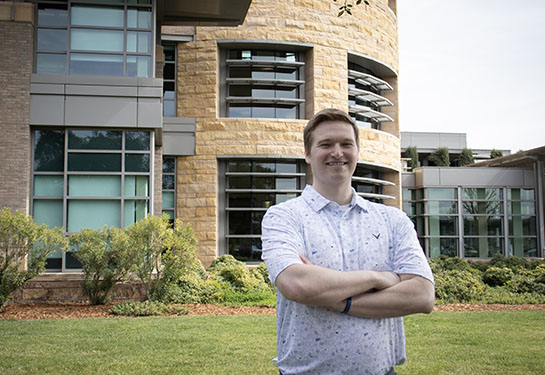ADHD symptoms in autistic children linked to neighborhood conditions
Study finds poverty, lack of services may play a role
Autistic youth who were born in underserved neighborhoods are more likely to have greater attention-deficit/hyperactivity disorder (ADHD) symptoms than those born in communities with more resources. This is one finding of a new study led by researchers at the UC Davis MIND Institute.
This is the first time researchers have investigated how neighborhood factors are associated with ADHD in autistic and non-autistic children. The study provides new insights into mental health conditions and has the potential to inform public policy changes to improve health equity.
It was published in the journal JCPP Advances.
“We found that some neighborhood factors are strongly related to ADHD symptoms in autistic children,” said Catrina Calub, the first author on the paper. Calub is a postdoctoral researcher in the laboratory of Julie Schweitzer, a professor in the Department of Psychiatry and Behavioral Sciences and the MIND Institute.
“In this study, we didn't find this effect in typically developing kids or in kids with other developmental disabilities, only in the autistic children. It suggests that when autistic kids live in neighborhoods with fewer resources, they tend to have more pronounced ADHD symptoms,” Calub said.
We found that some neighborhood factors are strongly related to ADHD symptoms in autistic children … It suggests that when autistic kids live in neighborhoods with fewer resources, they tend to have more pronounced ADHD symptoms.” —Catrina Calub, postdoctoral researcher, Department of Psychiatry and Behavioral Sciences
ADHD symptoms can include higher rates of inattention, hyperactivity and impulsive behavior.It is associated with:
- Challenges in school performance and relationships with friends
- Lower self-esteem and greater risk for anxiety and depression
- Higher potential for substance use disorders and accidents
- Emotional dysregulation and conduct problems
Study expands findings from long-term research
The researchers used data from two studies: the decades-long Childhood Autism Risks from Genetics and the Environment (CHARGE) study led by Irva Hertz-Picciotto at the MIND Institute and the ReCHARGE follow-up project.
CHARGE and ReCHARGE assess how genetics, environment and other factors affect development from early childhood (2–5 years) through adolescence (8-20 years).
The team looked at 246 autistic children, 85 with developmental delays (without autism), and 193 who were neurotypical. Then, they applied the Child Opportunity Index, which uses census data to track over 30 neighborhood traits. These traits include socioeconomics, green space, single-parent households and concentration of early childhood education centers.
The index encompasses three domains: education, health and environment, and social and economic resources. Higher scores are linked to better childhood health. Of the three domains, the education and social and economic resources scores were most strongly related to ADHD symptoms.
The analysis showed the Child Opportunity Index scores at birth were a strong predictor for ADHD symptoms in adolescence in the autistic children but not in the other groups. Calub noted that the finding was unexpected.
“These results are quite concerning,” Calub said. “Those with both autism and ADHD are already more likely to have additional challenges — behaviorally, cognitively, emotionally and socially. Being born in a low-income neighborhood puts them at an even greater disadvantage. This just adds to the evidence that more resources are needed for underserved areas and specifically for those who have conditions like autism.”
ADHD is highly prevalent in the general population and is common in autistic youth. If we can find ways to increase resources in these neighborhoods, we have the potential to improve academic, social, mental and physical health outcomes, particularly for autistic youth, and also decrease long-term economic costs.” —Julie Schweitzer, professor, Department of Psychiatry and Behavioral Sciences
The need for a larger, more diverse sample
Calub pointed out that more research is needed to determine if the results would apply to a larger group.
"It will be important for future studies to be larger and more diverse. That should help us learn whether neighborhood conditions might also influence ADHD symptoms in other groups such as youth without autism, or in Black, Asian and Native American individuals, who were under-represented in our sample," Calub added.
These findings also offer clues for how to target preventive strategies to reduce the risk of increased ADHD symptoms, noted Schweitzer, who was also a co-author on the study.
“ADHD is highly prevalent in the general population and is common in autistic youth. If we can find ways to increase resources in these neighborhoods, we have the potential to improve academic, social, mental and physical health outcomes, particularly for autistic youth, and also decrease long-term economic costs,” Schweitzer explained.
Calub and Schweizer believe the study’s findings should encourage policymakers to provide more resources for underserved communities. In addition, they hope including the Child Opportunity Index and other neighborhood metrics could provide new insights into future studies to inform policy.
Co-authors on the study include Irva Hertz-Picciotto and Deborah Bennett, both in the Department of Public Health Sciences at UC Davis. Read the full study.
The UC Davis MIND Institute in Sacramento, Calif. is a unique, interdisciplinary research, clinical, and education center committed to deepening scientific understanding of autism and other neurodevelopmental conditions. It is a highly collaborative center, bringing together families, researchers, clinicians, community leaders and volunteers with the common goal of developing more personalized, equitable, and scientifically proven systems of support and intervention. The institute has major research efforts in autism, fragile X syndrome, chromosome 22q11.2 deletion syndrome, attention-deficit/hyperactivity disorder (ADHD) and Down syndrome. More information about the institute and its Distinguished Lecturer Series, including previous presentations in this series, is available on the Web at mindinstitute.ucdavis.edu.






